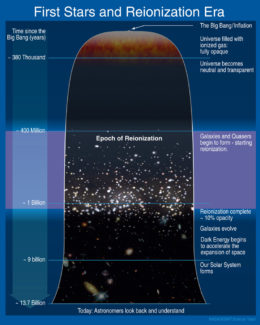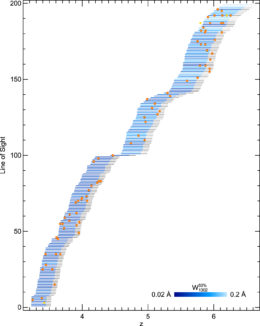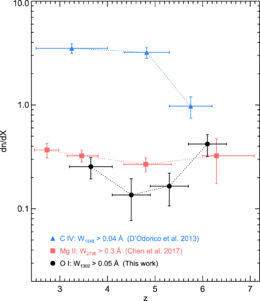When did the first sources of light bombard the universe’s gas, tearing electrons from atoms in a period known as reionization? A new study uses the metal-filled gas surrounding galaxies to learn more about this important transition.
Drama in the Early Universe

In the schematic timeline of the universe, the epoch of reionization is when the first galaxies and quasars began to form and evolve. [NASA]
How and when, exactly, did this period of reionization occur? One way we can seek to answer these questions is by studying the gas that lies both between and immediately around galaxies.
Clues from Distant Gas
While the broadly dispersed intergalactic medium (IGM) consists largely of hydrogen gas, the circumgalactic medium (CGM) immediately around galaxies is a little more complicated: it’s enriched with elements heavier than helium — “metals” — that have been produced by the galaxy’s stars and flung into the surrounding matter.
Because this distant gas is diffuse and dim, we can’t easily study its emission. Instead, we explore these clouds of gas by looking at how they absorb light from bright background sources.

The authors’ sample. Horizontal lines show the redshift interval over which each line of sight was surveyed for neutral oxygen. Orange dots mark the locations of identified neutral oxygen absorbers. [Becker et al. 2019]
Oxygen Signature Surprise
Becker and collaborators looked for the signatures of several metals in these clouds, including neutral oxygen. From their sample, the authors were able to infer how absorbing clouds containing neutral oxygen are distributed over cosmic time between redshifts of 3.2 < z < 6.5.
If circumgalactic gas were gradually enriched, we would expect to see the number density of neutral oxygen absorbers increase with decreasing redshift (closer to us, or longer time since the Big Bang), as metal-enriched gas continues to accumulate around galaxies over time.

Number density of neutral oxygen (black circles), singly ionized magnesium (red squares), and triply ionized carbon (blue triangles) absorbers as a function of redshift. Instead of decreasing monotonically with increasing redshift (as do highly ionized species like the C IV), O I absorber number density dips for redshifts below z ~ 6. [Becker et al. 2019]
Locking Down a Timeframe
What does this mean? The ionization of the metal-enriched gas immediately surrounding galaxies is directly linked to the reionization of the hydrogen in the broader intergalactic medium: for high-energy background radiation to reach the dense gas around galaxies and ionize it, this means that the surrounding IGM must recently have become ionized.
Becker and collaborators’ observations of metals therefore help us to pinpoint the final stages of the epoch of reionization in the universe, shedding light on how the universe evolved to its current form.
Citation
“The Evolution of O i over 3.2 < z < 6.5: Reionization of the Circumgalactic Medium,” George D. Becker et al 2019 ApJ 883 163. doi:10.3847/1538-4357/ab3eb5

1 Comment
Pingback: From AAS NOVA: “Distant Metals Reveal the Universe’s Evolution” | sciencesprings